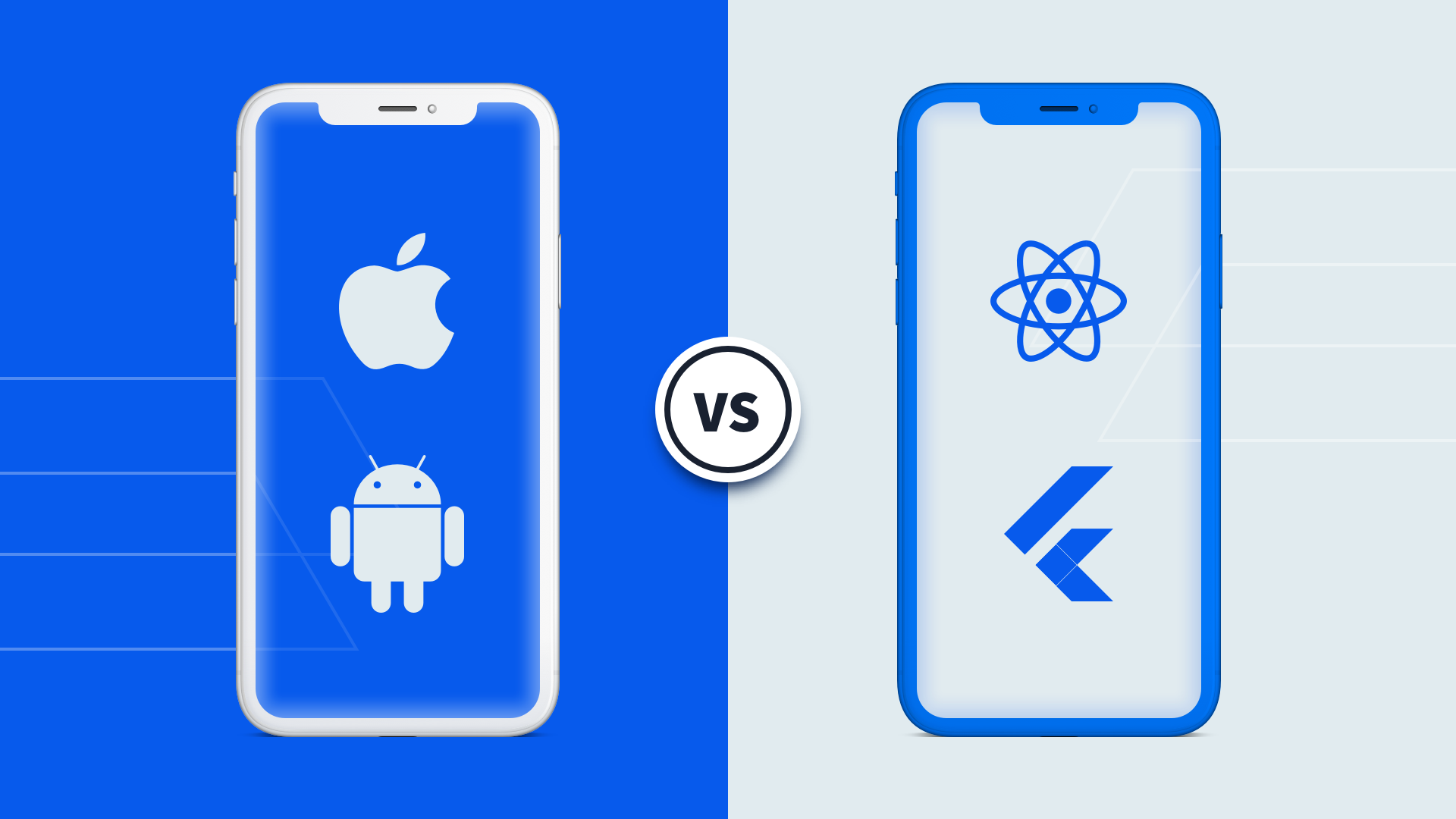Banks often ask us whether we use cross-platforms for banking applications. The answer is no, and we will explain you why. To make our point, we will discuss the main development approaches.
Understanding cross-platform applications: Definition and significance
Cross-platform applications are developed to be compatible with multiple operating systems (OS), such as iOS and Android, using a unified codebase. The key advantage of cross-platform development is its potential to save time and resources by eliminating the need for separate app development for each OS. Through the utilization of open-source frameworks like React Native or Flutter, developers can create impressive apps with relative ease. Nevertheless, it is crucial to evaluate whether cross-platform app development is always the most suitable approach for all scenarios.
Advantages and disadvantages of cross-platform apps
Cross-platform app development offers several advantages. It might seem that using them for banking (e.g. React Native, Kivy, Flutter) is a good idea because of the following:
- Using one framework and common code to build both apps for Android & iOS is efficient in terms of cost and time (but only when we take into account the fact that instead of hiring developers for the second platform, we will employ these additional individuals for cross-platform development) consumed for development.
- Having one developer who knows one code syntax instead of two simplifies the development and maintenance of the application in the future.
However, there are also some drawbacks to consider. Here they are:
- Compromising on quality and performance, which is not acceptable in banking.
- Some difficulties arise when accessing native features of mobile devices. Consequently, banks turn to native development when implementing advanced features since cross-platform tools often cannot accommodate selected functions.
- Sharing UI can result in limited consistency, making UI less intuitive for users of a given platform.
- The need to have strong competencies in native tools in the team to solve problems related to the lack of support for certain elements by the cross-platform tool, as well as to solve compatibility problems.
- Cross-platform frameworks are continuously evolving to keep up with native technologies. It means that addressing errors or implementing custom workarounds in cross-platform development can be time-consuming and posing challenges when serving a large customer base in mobile banking applications.
Are you hesitating about which option is the best for your banking project? If yes – get to know the most popular frameworks we write about below.
Technologies for cross-platform app development: Flutter, Kotlin, and Others
Several technologies have emerged as popular ones for cross-platform app development, which are:
-
- Flutter – an open-source* UI software toolkit developed by Google.
- Kotlin Multiplatform – a technology created and developed by JestBrains to streamline the development of cross-platform projects (this solution is still in the beta phase).
- React Native – an open-source JavaScript framework developed by Meta Platform, Inc.
- Xamarin – an open-source app platform for building Android and iOS apps with .NET and C#. It was developed by Xamarin, INC (currently part of Microsoft).
- Kivy – an open-source GUI Python framework created by Kivy organization.
Each of the above technologies has its strengths and weaknesses. The question which framework should be chosen depends on factors such as project requirements, development team expertise, and target audience. For detailed description of each technology we will present soon.
* Code which is freely accessible for developers to use, modify, and distribute.
If you still need advice on which solution would be the perfect one when it comes to mobile banking app development, simply contact a trustworthy company to dispel any doubts.
Native vs. cross-platform applications: A comparative analysis for banking
In this paragraph, we want to touch on 2 key development areas: security, UX.
SECURITY
Nothing will give you more protection than a native mobile banking application that uses a number of sophisticated mechanisms to increase security. When you use native technology, whole crucial support is available immediately after new algorithms or security mechanisms are released.
A dedicated, native platform, gives you better control over the syntax by writing lower-level code. The code is easier to debug, analyze and troubleshoot. Any problems that arise are much quicker and easier to identify by developers.
USER EXPERIENCE
Another very important aspect of native development is superb user experience. Dedicated UX design for each platform gives a fully natural ‘feel and look’ in accordance with the platform’s characteristics. Performance is also at its top speed of framerate, computing power or graphic support.
As seen in these areas, native development clearly excels.
Differences between native app and React Native app development
React Native is one of the most widespread cross-platform frameworks for mobile app development. Comparing it to native technologies, we can identify some key differences.
Native app development involves writing platform-specific code using languages like Swift or Java, providing direct access to the underlying platform’s capabilities. These programming languages are known for their strict typing and object-oriented nature.
In contrast, React Native uses JavaScript, allowing developers to build apps using a single codebase and deploy it across iOS and Android. Unfortunately, React Native has several issues and lacks sufficient documentation, making it harder for developers to find solutions and fix problems, slowing development and reducing efficiency. Also, this technology may require additional customizations and native modules (after all) to access certain platform-specific functionalities.
Regarding native app development frameworks, they have direct access to all types of APIs, allowing seamless accessibility.
In turn, React Native framework does not offer the same level of direct API access. Apps created with the usage of this framework have limited access to APIs during development, restricting their ability to incorporate complex ones. To implement them, developers must build a connection layer using native technologies.
Banking applications often require many API integrations, allowing them to interact with various systems and services, such as payment gateways, authentication systems, account management, transaction processing, and third-party financial services. Their role is to enable secure data exchange and seamless communication between the banking app and external systems, enhancing functionality, security, and user experience.
This clearly demonstrates that native development is a superior choice when extensive API integration is required. As you can see, when it comes to React Native, there is often a need to use native solutions, which is not so universal and self-sufficient.
Cross-platform finance apps: Final summary
In our opinion, cross-platform development might be a wise choice when it comes to simple applications, without constant development, but actually not the best choice for banking. We do not rule out that cross-platform app development will become an equally good choice in the next few years. We are watching how programming trends are changing and the direction in which the most popular languages/frameworks are developing.
However, as mentioned earlier, banking applications must continuously follow the latest market trends, e.g. implementing facial biometrics login, be properly protected.
Such novelties are not available immediately on cross-platform tools and usually find their way to them after some time (if at all).
For now, cross-platform development is an excellent option for following types of apps:
- internal enterprise apps,
- proof-of-concept apps,
- startup apps,
- utility apps
- and many others.
In the above cases, this programming approach may seem a good choice. Organizations with limited resources and tight timelines can benefit from cross-platform development as it allows them to reach multiple platforms simultaneously, reducing time and costs. But…
… we regularly do a review of banking applications available on the market. Based on our observations, we observe that apps made in cross-platform frameworks struggle with ratings in the stores, and their users usually highlight some problems due to inadequate UI/UX customization for specific platform.
What’s more, even the voices of developers dealing with cross-platform technologies on a daily basis testify to the need for constant problem-solving. Most of them are related to the lack of support for certain functions in such tools that are available natively. This in effect entails the need to use many native code inserts, which needs a very good knowledge of a given platform.
Additionally, we are aware of some performance issues that, in our opinion, currently pose a significant blocker, excluding their use in the development of mobile banking apps.
Of course, one should not forget about the risk of discontinuation of support and further development by its manufacturer, as well as possible problems related to certification before publishing the application in stores.
So, instead of minimizing the risks in the project, we can significantly increase them by choosing a cross-platform tool rashly.
Benefits and drawbacks of native app development
Native app development offers numerous benefits, especially for mobile banking applications. Here they are:
- Highest level of performance and responsiveness, as they are optimized for a specific OS.
- Seamless integration with device features such as Touch ID, Face ID, and secure payment systems, and hardware such as camera, microphone, and GPS location ensuring a robust and secure user experience.
- Extensive developer resources and support provided by platform-specific ecosystems.
Of course, native development is not free of weaknesses. The main ones include:
- Higher costs. Developing native apps involves having two different teams with different skills for each OS.
- More errors in code. It might be true in some cases. However, at Finanteq we developed a unique way of producing software with in-code testing scenarios which let eliminates them easily straight away. You can read it more about it below.
The quality and performance of the application far exceeds potential drawbacks.
The ins and outs of native mobile development
At Finanteq, thanks to more than 10 years of experience in the banking industry, we have developed the best practices in the field of mobile apps.
We have been working with top banks, such as Santander and National Bank of Kuwait for many years, creating mobile apps specifically for the two main operating systems, iOS and Android. This approach has proven to be highly successful in the banking industry and continues to be the primary choice for the majority of financial institutions.
What makes our approach to native development stand out?
We actively identifying and eliminating the disadvantages of native development and leveraging its unique strengths. Through continuous process improvement, optimized workflows we ensure that all projects are executed with the highest efficiency and deliver outstanding results.
Native development requires expertise in multiple programming languages and separate development efforts for each platform. At Finanteq, we employ only top-class specialists who not only code but also offer expertise and advise on the best solutions. Our tech-leads, on the other hand, take care of disseminating know-how and technical excellence within the organization.
Finanteq is a dedicated partner for any banking project. Our high-performing teams are distinguished by technical excellence. Our strengths come from a deep understanding of banking processes and proactive approach to suggest changes and provide best solutions.
All above aspects translate into fast, efficient and cost-effective development process.
Key Differences between native app development for various environments
Finanteq’s native developers excel on every platform.
For iOS development, we typically use Swift, taking advantage of Apple’s design principles and ecosystem.
Android development, on the other hand, relies on Java or Kotlin and follows Google’s Material Design guidelines.
Each OS has its own set of development tools, UI components, and APIs, requiring developers to adapt their approach accordingly.
Thank to using OS-specific programming languages best practices, we are able to build top-notch apps.
Native mobile applications: A final glance
All advantages mentioned above make native apps the preferred choice if you are looking for a reliable, high-quality, and well-performing application for banking. The costs of the cross-platform approach may seem lower initially, but it brings a range of risks, such as those related to long-term support for a specific tool or the need to use native code snippets, as many elements may not be covered by cross-platform tools. The choice between these two approaches depends on the specific situation, budget, implementation time, and the bank’s specific needs.
Are you looking for reliable partner to talk about creating or revamping your mobile banking app?
Schedule a call with Finanteq!







